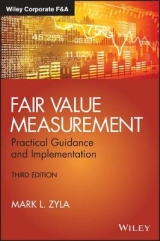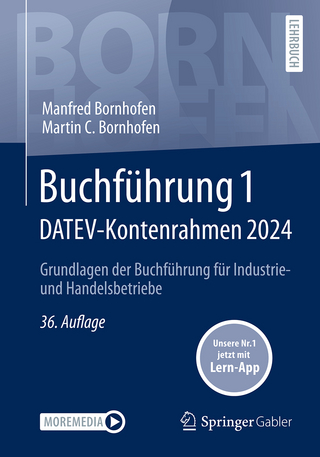
Fair Value Measurement
John Wiley & Sons Inc (Verlag)
978-1-118-22907-1 (ISBN)
- Titel ist leider vergriffen;
keine Neuauflage - Artikel merken
This is a critical area of valuations for financial reporting due to a false comfort given by routine application of evaluating models and assumptions without real possibilities of calibration. Mark Zyla offers an extraordinary help in understanding the reliability of the inputs and the outputs of the different methodologies and the inherent biases in each of them. The book is a precious support for better valuation both in U.S. GAAP and in IFRS fair value reporting." Mauro Bini, Full Professor of Corporate Finance, Bocconi University; Chairman, Management Board OIV (Organismo Italiano di Valutazione) Essential guidance on the fair value measurement process Now in a second edition, Fair Value Measurement: Practical Guidance and Implementation helps you succeed in understanding the fair value accounting rules that entities must follow. The result is a resource that you can rely on to understand the importance of valuation and the concepts that define it. In basic, nontechnical language, author Mark Zyla presents practical direction for best practices of financial valuation as well as for understanding the many FASB pronouncements involving fair value.
An essential guide for auditors and valuation specialists, Fair Value Measurement: Practical Guidance and Implementation, Second Edition brings you up to speed on what fair value really means.
MARK L. ZYLA, CPA/ABV, CFA, ASA, is a leader in the area of fair value measurement. He is Managing Director of Acuitas, Inc., an Atlanta, Georgia based valuation and litigation consultancy firm, providing valuation consulting for various entities for the purposes of mergers and acquisitions, financial reporting, tax planning, corporate recapitalizations, as well as valuing various types of intellectual property and other intangible assets. He has served as Chairman of the AICPA's Fair Value Measurement Conference and serves on the AICPA's Impairment Issues Task Force. He is also the author of the AICPA courses "Fair Value Accounting: A Critical New Skill for CPAs" and "Valuing Goodwill and Other Intangible Assets." He was vice chairman of the Appraisal Foundation's first Best Practices in Valuation for Financial Reporting Working Group. He serves on the faculty of the National Judicial College. Mark lives in Atlanta with his wife, JoAnn, and son, Jack.
Preface xiii Acknowledgments xix Chapter 1: The History and Evolution of Fair Value Accounting 1 Why the Trend toward Fair Value Accounting? 2 History and Evolution of Fair Value 7 Fair Value Accounting and the Economic Crisis 15 The FASB and IASB Convergence Project 22 The Future of Fair Value Measurement 29 Conclusion 30 Notes 31 Chapter 2: Fair Value Measurement Standards and Concepts 37 FASB ASC 820, Fair Value Measurement 38 Disclosures 65 Fair Value Option 69 Conclusion 78 Notes 78 Chapter 3: Business Combinations 79 Mergers and Acquisitions 80 Accounting Standards for Business Combinations A Brief History 83 ASC 805, Business Combinations 86 Other Business Combination Highlights 93 Subsequent Accounting for Goodwill and Other Intangible Assets 97 Conclusion 98 Notes 99 Chapter 4: The Nature of Goodwill and Intangible Assets 103 History of Intangible Assets 104 Intellectual Property 106 Economic Basis of Intangible Assets 106 Identification of Intangible Assets 108 Useful Life of an Intangible Asset 113 Intangible Assets and Economic Risk 114 Goodwill 115 Economic Balance Sheet 118 Conclusion 120 Notes 121 Chapter 5: Impairment 123 Evolution of Impairment Testing 125 Applicable FASB Guidance for Impairment Testing 127 Accounting for the Impairment of Long?]Lived Assets 128 Goodwill Impairment Testing 131 Testing Other Indefinite?]Lived Intangible Assets for Impairment 147 Conclusion 148 Notes 149 Appendix 5A: Example of a Qualitative Impairment Analysis PlanTrust, Inc. 151 Financial Accounting Standards Board ASC 350, Intangibles Goodwill and Other 151 PlanTrust, Inc. 152 Notes 170 Chapter 6: The Cost Approach 171 The Cost Approach under FASB ASC 820, Fair Value Measurement 172 Economic Foundation for the Cost Approach 175 Cost versus Price versus Fair Value 175 The Role of Expected Economic Benefits in the Cost Approach 178 Reproduction Cost versus Replacement Cost 178 Components of Cost 180 Obsolescence 182 The Relationships among Cost, Obsolescence, and Value 182 Physical Deterioration 184 Functional (Technological) Obsolescence 185 Economic (External) Obsolescence 186 Applying the Cost Approach 188 Taxes under the Cost Approach 192 Limitations of the Cost Approach 194 Conclusion 195 Notes 195 Chapter 7: The Market Approach 199 Measuring the Fair Value of an Entity Using a Market Approach 201 Conclusion 232 Notes 232 Appendix 7A: Using the Guideline Transaction Method to Measure the Fair Value of a Privately Held (or Thinly Traded) Debt Security 235 Chapter 8: The Income Approach 253 Discounted Cash Flow Method 254 Multiperiod Excess Earnings Method 262 FASB Concepts Statement 7 280 Rates of Return under the Income Approach 286 The Income Increment/Cost Decrement Method 287 Profit Split Method 288 Build?]Out Method, or Greenfield Method (With and Without) 294 Weighted Average Cost of Capital Calculation 294 Conclusion 303 Notes 303 Chapter 9: Advanced Valuation Methods for Measuring the Fair Value of Intangible Assets 307 Limitations of Traditional Valuation Methods 308 Real Options 309 Using Option?]Pricing Methodologies to Value Intangible Assets 313 Black?]Scholes Option Pricing Model 317 Binomial or Lattice Models 320 Monte Carlo Simulation 327 Decision Tree Analysis 328 Conclusion 331 Notes 331 Chapter 10: The Remaining Useful Life of Intangible Assets 333 FASB Guidance on Determining the Remaining Useful Life 333 Considerations in Measuring Useful Lives of Intangible Assets 336 Guideline Useful Lives 341 Conclusion 342 Notes 342 Chapter 11: Fair Value Measurement for Alternative Investments 345 Investments in Certain Entities That Calculated Net Asset Value per Share 347 AICPA Technical Practice Aid 349 AICPA Guidance for Determining the Fair Value of Investment 351 U.S. Private Equity Valuation Guidelines 356 Fair Value Measurement for Alternative Investment Funds 357 Conclusion 359 Notes 360 Chapter 12: Contingent Consideration 361 Contingent Consideration: Earn?]Outs in Business Combinations 362 Accounting for Contingent Consideration 363 Conclusion 376 Notes 377 Appendix 12A: Measuring the Fair Value of a Loan Guarantee 379 The Jordan Lee Fund Guarantee of Townsend Farm Development, LLC 381 Notes 387 Chapter 13: Auditing Fair Value Measurement 389 Auditing Standards 390 Audit Standards for Fair Value Measurements and Disclosures 392 The Audit Process 394 Auditing Estimates in Fair Value Measurements 399 AU 328, Auditing Fair Value Measurements and Disclosures 400 PCAOB Staff Audit Practice Alert No. 2 409 PCAOB Staff Audit Practice Alert No. 9 413 SEC Audit Guidance 415 AICPA Non?]Authoritative Guidance 416 The Appraisal Foundation 416 Conclusion 417 Notes 418 Appendix 13A: Auditing a Business Combination or a Step 2 Impairment Test 421 General 421 Income Approach 423 Cost Approach 426 Market Approach 427 Appendix 13B: Auditing a Step 1 Goodwill Impairment Test 429 General 429 Income Approach 430 Market Approach 432 Appendix 13C: Survey of Fair Value Audit Deficiencies 435 Audit Deficiencies Increase in Difficult Economic Times 436 PCAOB Inspections 436 Methodology 437 Description of a Deficiency 438 Audit Deficiency Trends 438 FVM Deficiencies 440 Impairment Deficiencies 442 Conclusion 443 Notes 445 Chapter 14: Fair Value Measurement Case Study 447 Learning Objectives 447 Business Background and Facts Mobile Apps Source, Inc. 448 Note 484 Appendix 14A: Suggested Case Study Solutions 485 Information Request ASC 350 517 Information Request for Business Combination ASC 805 519 Glossary of International Business Valuation Terms 523 Bibliography 533 About The Author 547 Index 549
| Reihe/Serie | Wiley Corporate F&A |
|---|---|
| Verlagsort | New York |
| Sprache | englisch |
| Maße | 159 x 235 mm |
| Gewicht | 848 g |
| Themenwelt | Wirtschaft ► Betriebswirtschaft / Management ► Rechnungswesen / Bilanzen |
| ISBN-10 | 1-118-22907-X / 111822907X |
| ISBN-13 | 978-1-118-22907-1 / 9781118229071 |
| Zustand | Neuware |
| Haben Sie eine Frage zum Produkt? |
aus dem Bereich



